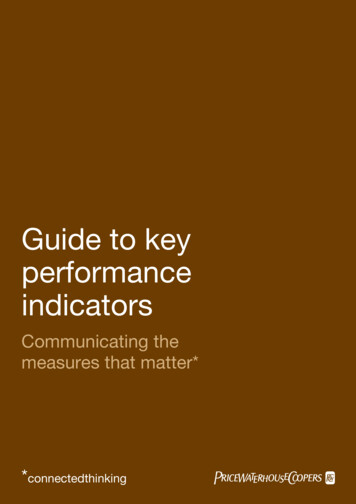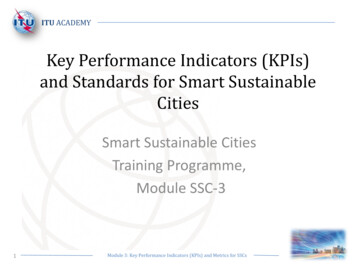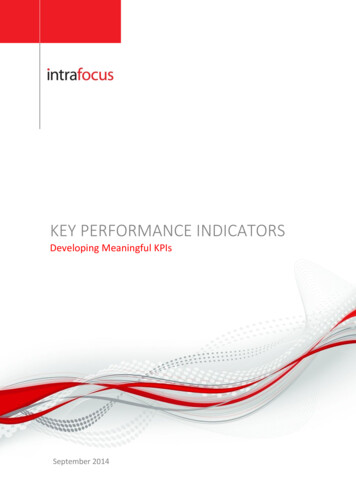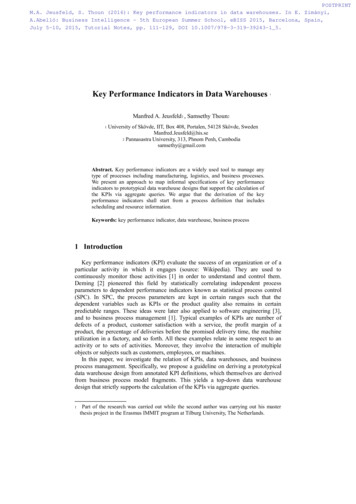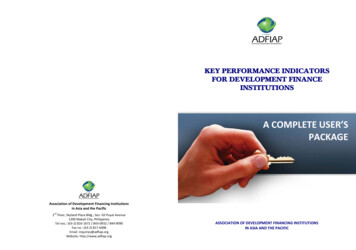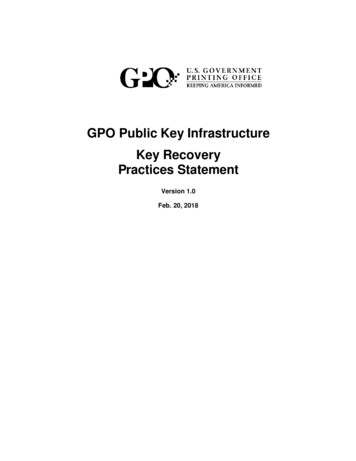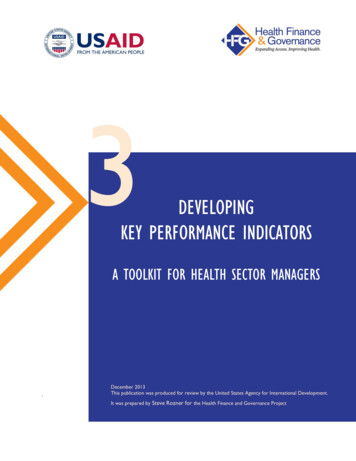
Transcription
3DEVELOPINGKEY PERFORMANCE INDICATORSA TOOLKIT FOR HEALTH SECTOR MANAGERS.December 2013This publication was produced for review by the United States Agency for International Development.It was prepared by Steve Rozner for the Health Finance and Governance Project
The Health Finance and Governance ProjectUSAID’s Health Finance and Governance (HFG) project will help to improve health in developing countries byexpanding people’s access to health care. Led by Abt Associates, the project team will work with partner countriesto increase their domestic resources for health, manage those precious resources more effectively, and make wisepurchasing decisions. As a result, this five-year, 209 million global project will increase the use of both primaryand priority health services, including HIV/AIDS, tuberculosis, malaria, and reproductive health services. Designedto fundamentally strengthen health systems, HFG will support countries as they navigate the economic transitionsneeded to achieve universal health care.December 2013Cooperative Agreement No: AID-OAA-A-12-00080Submitted to:Scott Stewart, AOROffice of Health SystemsBureau for Global HealthRecommended Citation: Rozner, Steve. December 2013. Developing and Using Key Performance IndicatorsA Toolkit for Health Sector Managers. Bethesda, MD: Health Finance & Governance Project, Abt Associates Inc.Abt Associates Inc. 4550 Montgomery Avenue, Suite 800 North Bethesda, Maryland 20814T: 301.347.5000 F: 301.652.3916 www.abtassociates.comBroad Branch Associates Development Alternatives Inc. (DAI) Futures Institute Johns Hopkins Bloomberg School of Public Health (JHSPH) Results for Development Institute (R4D) RTI International Training Resources Group, Inc. (TRG)
DEVELOPING AND USING KEYPERFORMANCE INDICATORSA TOOLKIT FOR HEALTH SECTOR MANAGERSDISCLAIMERThe author’s views expressed in this publication do not necessarily reflect the views of the United StatesAgency for International Development (USAID) or the United States Government.
CONTENTSAcronyms. iiiAcknowledgments . vIntroduction. 1What are KPIs? . 3Using KPIS in the Health Sector . 5Linking KPIS to Strategy . 7Linking KPIS to Programs . 11Characteristics of Good KPIS. 15Distinguishing Causes from Results . 17Types of Indicators . 18Setting KPI Targets . 23Using Health Information Systems to Manage KPI Data . 31Defining the Frequency of KPI Reporting . 35Interpreting KPI Data . 37Conclusion. 39Annex A: Templates for Logic Models . 41Annex B. Special Types of Indicators . 43Annex C. Sample KPIs . 47Annex D: KPI Template . 51Annex E: References . 55List of TablesTable 1. Cause and Result Indicators: A Compariso . 17Table 2. Inputs, Outputs, Outcomes, and Efficiency Indicators:Strengths and Weaknesses . 19Table 3. Input, Process, Output, Outcome, and Efficiency Indicators:Some Basic Illustrations . 21Table D.1. KPI Template . 51Table D.2. Example of Clinical KPI Using the KPI Template . 52i
List of FiguresFigure 1. Using a Logic Model to Sharpen Focus on Strategic Plan Goals . 8Figure 2. Logic Model for Program Planning . 12
ACRONYMSARTAntiretroviral therapyARVAntiretroviralHFGHealth Finance and Governance Program (USAID)HISHealth Information SystemGFMISGovernment (integrated) financial management information systemsHMISHealth Management Information SystemICTInformation and communications technologyKPIKey Performance IndicatorMDSMinimum data setMOFMinistry of FinanceMOHMinistry of HealthM&EMonitoring and evaluationPIPerformance IndicatorSMARTSmart, Measurable, Achievable, Relevant, Time-boundTBTuberculosisUSAIDUnited States Agency for International DevelopmentWHOWorld Health Organizationiii
ACKNOWLEDGMENTSThis toolkit would not have been possible without the trust, patience, and cooperation ofJeremy Kanthor and the Health Finance and Governance (HFG) Program team. Specialthanks also go to Fred Rosensweig, Victor Zafra, and Mark Gallagher for their illuminatingsuggestions and feedback.Of course, any errors, omissions, or contradictions that remain are solely the responsibilityof the authorv
INTRODUCTIONOver the last several decades, governments worldwide have introduced budgetary andreporting mechanisms designed to demystify government operations and illuminate howpublic funds are being used to achieve policy goals. Whether dubbed “program” budgeting,“performance” budgeting, or “results-based” budgeting, the trend has seen a conceptualshift from an approach that was heavily oriented to inputs, to models designed to providegovernment decision makers, parliaments, and citizens with a clearer picture of whatgovernments achieve for the public funds they spend. Performance measurement, and theuse of key performance indicators (KPIs), is an integral part of any of these models,providing feedback to inform and improve public service delivery and promotingaccountability by demonstrating to key stakeholders the results that government isachieving.Few economic sectors depend on performance information as intensively as does publichealth, where safety, speed, access, and cost can literally be “life or death” matters. Withgrowing demands to improve health care quality, coverage, and outcomes, health sectordecision makers not only face the challenge of allocating resources to the highest priorities,but also of ensuring that those resources are put to good use, deliver “value for money,”and achieve the intended outcomes or impact. KPIs are central to this agenda. Moreover,because of their importance to both budget management and accountability, KPIs alsorepresent a key point of convergence between ministries of health (MOHs) and ministriesof finance (MOFs) or, where separate from the MOF, the central budget authority.This tool provides useful guidance on developing and using KPIs and building these into thebudget process, with a particular focus on the health sector. Specifically, it offersgovernment managers responsible for planning, program implementation, monitoring andevaluation (M&E)—particularly in central or federal ministries of health—guidelines and tipsfor thinking strategically about program planning, defining performance indicators, settingKPI targets, and harnessing performance information. These factors are not presented as aseries of steps, and although some may follow a logical order, the KPI journey does notalways follow a straight line, but is part of a dynamic process influenced by programmatic,institutional, and political imperatives.This document and its annexes also feature handy checklists, guidance, and templates tofacilitate the work of planning, program, and M&E managers and analysts in developing andusing KPIs as a performance management tool. The annexes also include a sampling of KPIsbased on international experience; however, it is important to remember that each countryfaces different policy challenges, to which it applies different government responses, forwhich it must use different performance metrics to define and measure success. For a morerobust presentation of sample KPIs that could be adapted to specific countrycircumstances, the World Health Organization (WHO) also produces an annualcompendium of standard definitions and measurement guidelines for an extensive list ofglobal health indicators (http://www.who.int/gho/publications/world health statistics/).1
This guide represents one installment in a series of toolkits developed through USAID’sHealth Finance and Governance (HFG) program to foster a more productive workingrelationship between the MOH and MOF, by boosting MOH capacities and systems and byenabling MOH and MOF staff to speak a common language. Using KPIs to monitor andevaluate performance will enable health sector managers to pinpoint and address gaps inperformance, while providing meaningful information with which to demonstrate resultswhen justifying budget requests, including requests for increased health sector allocations,through the budget process. This tool will not only help ministries of health to define andtrack the success of their programs, but also to communicate to the MOF, key politicaldecision makers, and the public how resources are being used for the social good22
WHAT ARE KPIs?Simply defined, KPIs are measures that a sector or organization uses to define successand track progress in meeting its strategic goals. This focus on strategic or long-termgoals is what distinguishes KPIs from the wider array of “performance indicators” (PIs)that do not necessarily rise to the attention of policymakers or the public, but may beimportant for public sector managers.KPIs are by no means a new phenomenon. The private sector has long embraced themas an important management tool to track and explain progress toward corporate ororganizational goals. In the public sector, growing interest in KPIs has been driven bymore complex factors, including the following: Increasing citizen demands for government accountability Increasing legislative scrutiny of government operations Ongoing shifts from input- to program- and performance-based budgeting Mounting fiscal pressures and the resulting need to use public funds and deliverpublic services as efficiently and effectively as possible.Against this backdrop, KPIs have become an important part of the suite of toolsgovernments used in most advanced economies, and increasingly in middle- and lowincome countries, to systematically monitor, evaluate, and continuously improve serviceperformance. In and of themselves, KPIs cannot improve performance. However, theydo provide “signposts” that signal progress toward goals and objectives as well asopportunities for improvement.3
USING KPIS IN THE HEALTH SECTORFew sectors of the economy depend on performance metrics as much as the healthsector does. Within any health system, there can be many indicators of performance,from the facility level (hospitals, clinics, pharmacies), to the district or provincial level, allthe way up to the national level, where information on the performance of health sectorprograms is typically aggregated for consideration by government leaders andpolicymakers. Yet, only a select group of these indicators are systematically measured,aggregated, and tracked at higher levels. These key performance indicators, or KPIs, areused because they highlight those aspects of performance that are integral above allothers in providing insights on attaining the health sector’s strategic goals, whether theybe around promoting healthy populations, equitable access to health services, orreduction of preventable diseases.Well-designed KPIs should help health sector decision makers to do a number of things,including: Establish baseline information (i.e., the current state of performance) Set performance standards and targets to motivate continuous improvement Measure and report improvements over time Compare performance across geographic locations Benchmark performance against regional and international peers or norms Allow stakeholders to independently judge health sector performance.In any given country, these stakeholders can include a broad cross-section ofconstituencies, including the parliament, the supreme audit institution, service recipients,civil society, donor institutions, and, critically, the MOF, for whom the financial and nonfinancial performance of spending agencies are typically central concerns.For MOHs and MOFs alike, the performance information generated from KPIs can helpto underscore the relationship between resources, activities, and results. By aligningfinancial costs with overarching performance objectives, KPIs can allow the MOH toshow how resource changes affect outcomes and to project, year by year, the resourcesrequired to meet service standards, keep up with workloads, or even secure future costsavings, for instance, through investments in program expansion, process improvement,or technology upgrades today.In turn, these performance measures can be used to define performance commitments,in terms of service delivery and internal efficiency, and the outcomes a spending ministryor agency expects to achieve through its budget allocations. Resource allocationchoices, thus, can be better informed by—or even linked to—sectoral performance,targets, and projected workloads. Of course, KPIs cannot replace political imperatives asa key driver of policy and budgetary decisions; however, they can reinforce or evenchange such decisions by communicating vital information about program results.5
KPIs can then be used as an ongoing source of management information, arming healthsector managers with critical data to plan, revise, add, and cut programs; report results;and communicate and align strategy across the sector to better ensure that all the keyparts of the health system—from laboratories and clinics, to operators along the healthsupply chain—are working to achieve the same strategic goals. Gathering the samefigures year by year will gradually paint a sharper picture, for example, of how well theMOH is maintaining consistency in patient care, how productive its various personnelare, where supplies are in surplus or deficit, where costs are rising or declining, andwhere service delivery is getting better or worse. This information, in turn, can provideinsight into changing needs, demands, and trends (e.g., using data on hospital diagnosesto drive drug orders), and can be used as reference points in costing and constructingannual budget estimates for the health sector.66
LINKING KPIS TO STRATEGYKPIs are not created in a vacuum. To be of value to decision makers, they must be partof the sector’s strategic framework. To this end, they need to be able to helpcommunicate the strategy, as well as foster common purpose across programs, facilities,and workforces.KPI development, therefore, starts with good strategic planning. Strategic planningintegrates policy, planning, budgeting, management, and review at different levels: Within the spending ministry Between a spending ministry and its departments, agencies, and front-line servicedelivery units Between and among spending ministries Between national and subnational levels of government Between a spending ministry and national government policies and priorities.KPIs, and PIs more broadly, can help to make these policies and priorities explicit. SouthAfrica, for instance, has had a system of identified national health priorities since the1990s—namely national health insurance, HIV/AIDS, tuberculosis, primary health care,and maternal and child health—and, since that time, has used KPIs and routine healthinformation systems (HIS) to facilitate data gathering, processing, and reporting to trackprogress toward achieving those priorities.KPIs, thus, should not be thought of as standalone measures, but rather as the product ofstrategic thinking, analysis, and negotiation around policy problems and responses. Auseful tool to help conceptualize this production process is the “logic model.” Instrategic planning, logic models are used commonly to describe the logical linkagesbetween problems and their solutions. The model (Figure 1) lays out a three-stageprocess for:1.Identifying the problem(s), or the community need2.Developing policies or measures to address the problem(s)3.Articulating the desired goals—the end-state of affairs or vision for the future.7
Figure 1 presents this logic model graphically, illustrating how the model might beapplied to setting strategic goals and framing policies around a particular health careconcern.Figure 1. Using a Logic Model to Sharpen Focus on Strategic Plan GoalsProblems and NeedsPoliciesGoalsPeople mostly visit health centerswhen they experience illness orinjury, not as part of routine orpreventive health maintenance,driving up healthcare costs and theincidence of preventable medicalconditions.Create incentives for proactivehealth maintenance (e.g., reducedfee or free preventive visits),and/or disincentives for unhealthyhabits (e.g., “sin taxes” on theconsumption of specific items, suchas tobacco or alcohol).To reduce morbidity and its costs tosociety through enhancedincentives to practice healthylifestyles.In practical terms, it might be more productive to reverse steps 2 and 3, first focusingon the goals to be achieved and then designing the policies or measures to achievethem. Yet regardless of how you order the steps conceptually, it is important toStrategic Plans and the Budget ProcessStrategic planning is a dynamic process occurring on several levels and at regularintervals. Typically, the government's high-level strategic goals are set either before orat the beginning of the annual budget process, and typically by senior officials. Multiyear national, sectoral, and organizational goals and objectives are set in documentssuch as the national development plan, poverty reduction strategy paper, and ministrylevel strategic and operational plans. Annual high-level goals and objectives are set indocuments such as the medium-term fiscal framework and, in some countries, inannual statements outlining the budget policies and priorities. It is important forplanning, program, and budget analysts, in the MOH or any other spending ministry, tounderstand these goals and how they are set, because it will ultimately fall on them torecommend how to structure programs and allocate funding to best achieve these goals.Strategic plans are not only essential budget-setting tools, but also key instruments inthe accountability process, as they provide critical information for lawmakers, auditors,and the public to assess and debate ongoing and proposed government programs andspending. KPIs, then, provide the measurable evidence that government programs are,in fact, helping to advance progress toward expressed goals, outcomes, and results.Published plans can also allocate responsibility for delivering those results and formthe foundation of performance contracts, service-level agreements, and otherperformance management schemes.88
recognize that the logic model applies a linear construct to simulate a multi-dimensionalpr
Oct 03, 2014 · use of key performance indicators (KPIs), is an integral part of any of these models, providing feedback to inform and improve public service delivery and promoting accountability by demonstrating to key stakeholders the results that government is achieving. Few economic sectors depend



